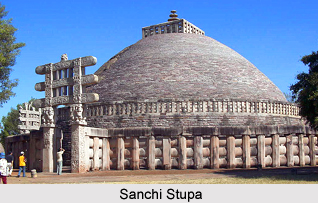 Sanchi was one of the largest Buddhist pilgrimage centers and has numerous temples and monasteries. While the remnants of the buildings are important sources of architectural history, the carvings on the toranas in front of the stupas are even more valuable. Very pastoral in nature, they depict cities, forts, the customs and lifestyles of the times, thereby acting as a historical resource.
Sanchi was one of the largest Buddhist pilgrimage centers and has numerous temples and monasteries. While the remnants of the buildings are important sources of architectural history, the carvings on the toranas in front of the stupas are even more valuable. Very pastoral in nature, they depict cities, forts, the customs and lifestyles of the times, thereby acting as a historical resource.
The biggest Sanchi stupa was built in the 3rd century BC, during the reign of Ashoka. It was constructed with brick. The present Stupa 1 in Sanchi was built in the 2nd century A.D. during the reign of the Sunga dynasty has at the apex a square stone with an umbrella-like canopy over it. The Stupa stands on a high platform and has two levels. The hen-coop design of the stone fence around the whole structure is adopted from a primitive style of wood fencing. All four entrances have magnificent toranas belonging to the 1st century, that stand on two pillars on which are suspended three long and thin flat stones. The Buddhist Stupa 3 follows the architectural pattern of Stupa1 and has a foundation platform and toranas. Stupa 2, at the foot of the hill, has a fence around it but no toranas. Stupa 1 has a three-tiered umbrella-shaped canopy, but in contrast Stupa 3 has a very simple canopy and the one on Stupa 2 is broken. There are many small stupas, which indicate that stupas were venerated even before the advent of Lord Buddha. These scenes can be seen in the relief work on the toranas.
The Temple 17 in Sanchi is the most important temple on the hill and has influences of the architecture of the Gupta dynasty of fifth and Seventh century. The Temple 18 has the chaitya style design of a circular rear and a straight front facade. The Stupa at the far end of the temple is broken. Temple 31, which was built much later, has a statue of Gautama Buddha that was worshipped by many. Buddhist architectural style is also reflected in the monasteries and monastery 51 is the most orderly of all. There are various rooms surrounding a courtyard and the monk`s rooms are in a row, separated by a corridor. The shrine was straight across the entrance. Monastery 45 had a tower-like room on top of the shrine. Corridors, with three rooms on each side are extended on either side of the shrine.
Thus the architectural style of Sanchi is mainly influenced by Buddhism. Buddhist architecture flourished under the reign of emperor Ashoka who built eighty four thousand stupas in Sanchi.



















